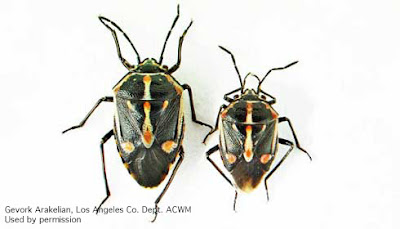
Bagrada bugs and other nasties can sneak into gardens

|
|
At the Fair Oaks Horticulture Center's Herb Garden,
the sweet alyssum was on its way out and now it's gone.
(Photo: Kathy Morrison)
|
Sweet alyssum produces a lovely cloud of white blossoms in any flower bed. In the Herb Garden of the Fair Oaks Horticulture Center this summer, it surrounded a beautiful 'Golden' pineapple sage.
That latter sentence is past tense because this morning I pulled out all the alyssum in the container, as well as the two clumps that were growing in a raised bed nearby.
Why yank them out? Well, it's getting to be fall planting season, and soon the FOHC's Vegetable Garden crew will be planting their brassicas -- cool-weather cole crops that include cauliflower, cabbage, kale, turnips and mustard greens. Alyssum also is part of that family.
You know which pest is attracted to brassicas? The bagrada bug, a nasty stink bug that was first seen in Southern California about 2008 and has spread north since.
The alert to the Herb group went out from master gardener/vegetable expert Gail Pothour -- she'd been checking around and under our lush alyssum for offenders. So far she'd only seen harlequin bugs (more about those in a minute) but the concern was there.
So there's no point making the vegetable gardeners' job harder: Out went the alyssum.
Those of us who mostly grow summer vegetables are accustomed to battling aphids, tomato hornworms, spider mites and leaf-footed bugs. But even though the weather's still very warm, fall planting plans have to include prevention of the pests of cool-weather crops.

|
|
Bagrada bugs are only 1/4-inch long; the female
is larger than the male. (Courtesy UC IPM)
|
In addition to monitoring or removing potential host plants, including weeds, the gardeners also put floating row covers on hoops over the vegetable seedlings. This is to deter those little butterflies you see in the fall from laying eggs on the plants. Those eggs grow into cabbageworms (white butterflies) and cabbage loopers (brown moths), which will skeletonize the leaves given the chance.

|
|
The harlequin bug is 3/8-inch long and is brightly colored.
(Courtesy UC IPM) |
If you find bagrada, harlequin or other stink bugs in the garden, handpicking is the easiest way to handle them. Don't squish them -- there's a reason they're called stink bugs. Instead, knock them into a bucket of soapy water. And keep a close watch for additional invaders; they can multiply quickly. Your fall and winter crops depend on your vigilance.
Comments
0 comments have been posted.Sacramento Digs Gardening to your inbox.
Sites We Like
Garden Checklist for week of April 14
It's still not warm enough to transplant tomatoes directly in the ground, but we’re getting there.
* April is the last chance to plant citrus trees such as dwarf orange, lemon and kumquat. These trees also look good in landscaping and provide fresh fruit in winter.
* Smell orange blossoms? Feed citrus trees with a low dose of balanced fertilizer (such as 10-10-10) during bloom to help set fruit. Keep an eye out for ants.
* Apply slow-release fertilizer to the lawn.
* Thoroughly clean debris from the bottom of outdoor ponds or fountains.
* Spring brings a flush of rapid growth, and that means your garden needs nutrients. Fertilize shrubs and trees with a slow-release fertilizer. Or mulch with a 1-inch layer of compost.
* Azaleas and camellias looking a little yellow? If leaves are turning yellow between the veins, give them a boost with chelated iron.
* Trim dead flowers but not leaves from spring-flowering bulbs such as daffodils and tulips. Those leaves gather energy to create next year's flowers. Also, give the bulbs a fertilizer boost after bloom.
* Pinch chrysanthemums back to 12 inches for fall flowers. Cut old stems to the ground.
* Mulch around plants to conserve moisture and control weeds.
* From seed, plant beans, beets, cantaloupes, carrots, corn, cucumbers, melons, radishes and squash.
* Plant onion sets.
* In the flower garden, plant seeds for asters, cosmos, celosia, marigolds, salvia, sunflowers and zinnias.
* Transplant petunias, zinnias, geraniums and other summer bloomers.
* Plant perennials and dahlia tubers for summer bloom.
* Mid to late April is about the last chance to plant summer bulbs, such as gladiolus and tuberous begonias.
* Transplant lettuce seedlings. Choose varieties that mature quickly such as loose leaf.